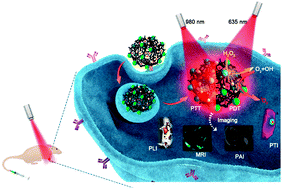当前位置:
X-MOL 学术
›
Mater. Chem. Front.
›
论文详情
Our official English website, www.x-mol.net, welcomes your
feedback! (Note: you will need to create a separate account there.)
Peroxidase-like Fe3O4 nanocomposite for activatable reactive oxygen species generation and cancer theranostics†
Materials Chemistry Frontiers ( IF 6.0 ) Pub Date : 2018-04-16 00:00:00 , DOI: 10.1039/c8qm00098k Kai Zhang 1, 2, 3, 4, 5 , Zhou Yang 4, 5, 6, 7, 8 , Xiangdan Meng 1, 2, 3, 4, 5 , Yu Cao 1, 2, 3, 4, 5 , Yuedong Zhang 1, 2, 3, 4, 5 , Wenhao Dai 1, 2, 3, 4, 5 , Huiting Lu 1, 2, 3, 4, 5 , Zhaofeng Yu 4, 5, 6, 7, 8 , Haifeng Dong 1, 2, 3, 4, 5 , Xueji Zhang 1, 2, 3, 4, 5
Materials Chemistry Frontiers ( IF 6.0 ) Pub Date : 2018-04-16 00:00:00 , DOI: 10.1039/c8qm00098k Kai Zhang 1, 2, 3, 4, 5 , Zhou Yang 4, 5, 6, 7, 8 , Xiangdan Meng 1, 2, 3, 4, 5 , Yu Cao 1, 2, 3, 4, 5 , Yuedong Zhang 1, 2, 3, 4, 5 , Wenhao Dai 1, 2, 3, 4, 5 , Huiting Lu 1, 2, 3, 4, 5 , Zhaofeng Yu 4, 5, 6, 7, 8 , Haifeng Dong 1, 2, 3, 4, 5 , Xueji Zhang 1, 2, 3, 4, 5
Affiliation

|
Photodynamic therapy (PDT) that utilizes apoptosis induced by reactive oxygen species (ROS) has received extensive attention in practical cancer therapy. However, the hypoxic microenvironment of solid tumors significantly limits the efficacy of therapy. Approaches that overcome the barriers to PDT in hypoxic conditions by simultaneously producing ROS exogenously and improving the oxygenation of tumors have never been studied. Herein, an activatable ROS platform was designed that uses the high reactivity of peroxidase-like Fe3O4 toward endogenous hydrogen peroxide (H2O2) to concurrently generate ˙OH as a therapeutic agent and provide O2 for oxygen-dependent PDT. Multifunctional chitosan-encapsulated Fe3O4 nanoparticles modified with CuS and porphyrin (FCCP NPs) were fabricated to achieve multimodal imaging and synergetic therapy. The FCCP NPs possess enhanced intrinsic peroxidase mimetic activity to produce ROS and O2 from endogenous H2O2. Multimodal imaging in vivo, including photoacoustic imaging (PAI), magnetic resonance imaging (MRI), photoluminescence imaging (PLI), and photothermal imaging (PTI), exploits the tumor-targeting property of FCCP NPs upon intravenous injection. It can induce cancer cell death with remarkable efficiency both in vitro and in vivo via synergetic treatment with PDT and photothermal therapy (PTT). This study demonstrates the promise of the activatable generation of ROS and O2 for PDT with nanotechnology to overcome a current deficiency in cancer therapies.
中文翻译:

类似于过氧化物酶的Fe 3 O 4纳米复合材料,可活化的活性氧生成和癌症治疗学†
利用由活性氧(ROS)诱导的细胞凋亡的光动力疗法(PDT)在实际的癌症治疗中受到了广泛的关注。然而,实体瘤的低氧微环境明显限制了治疗的有效性。从未研究过通过同时外源性产生ROS和改善肿瘤氧合作用来克服低氧条件下PDT障碍的方法。在本文中,设计了一种可活化的ROS平台,该平台利用过氧化物酶样Fe 3 O 4对内源性过氧化氢(H 2 O 2)的高反应性,同时生成˙OH作为治疗剂并为氧依赖性PDT提供O 2。多功能壳聚糖包埋铁制备了用CuS和卟啉(FCCP NPs)修饰的3 O 4纳米颗粒,以实现多峰成像和协同治疗。所述FCCP纳米粒具有增强本征过氧化物酶模拟物的活性,以产生ROS和O 2从内源性ħ 2 ö 2。包括光声成像(PAI),磁共振成像(MRI),光致发光成像(PLI)和光热成像(PTI)在内的体内多峰成像可在静脉注射时利用FCCP NP的肿瘤靶向特性。它可以通过体外和体内诱导癌细胞死亡,效率极高。PDT和光热疗法(PTT)的协同治疗。这项研究证明了利用纳米技术可激活PDT产生ROS和O 2的前景,以克服目前癌症治疗中的不足。
更新日期:2018-04-16
中文翻译:

类似于过氧化物酶的Fe 3 O 4纳米复合材料,可活化的活性氧生成和癌症治疗学†
利用由活性氧(ROS)诱导的细胞凋亡的光动力疗法(PDT)在实际的癌症治疗中受到了广泛的关注。然而,实体瘤的低氧微环境明显限制了治疗的有效性。从未研究过通过同时外源性产生ROS和改善肿瘤氧合作用来克服低氧条件下PDT障碍的方法。在本文中,设计了一种可活化的ROS平台,该平台利用过氧化物酶样Fe 3 O 4对内源性过氧化氢(H 2 O 2)的高反应性,同时生成˙OH作为治疗剂并为氧依赖性PDT提供O 2。多功能壳聚糖包埋铁制备了用CuS和卟啉(FCCP NPs)修饰的3 O 4纳米颗粒,以实现多峰成像和协同治疗。所述FCCP纳米粒具有增强本征过氧化物酶模拟物的活性,以产生ROS和O 2从内源性ħ 2 ö 2。包括光声成像(PAI),磁共振成像(MRI),光致发光成像(PLI)和光热成像(PTI)在内的体内多峰成像可在静脉注射时利用FCCP NP的肿瘤靶向特性。它可以通过体外和体内诱导癌细胞死亡,效率极高。PDT和光热疗法(PTT)的协同治疗。这项研究证明了利用纳米技术可激活PDT产生ROS和O 2的前景,以克服目前癌症治疗中的不足。











































 京公网安备 11010802027423号
京公网安备 11010802027423号